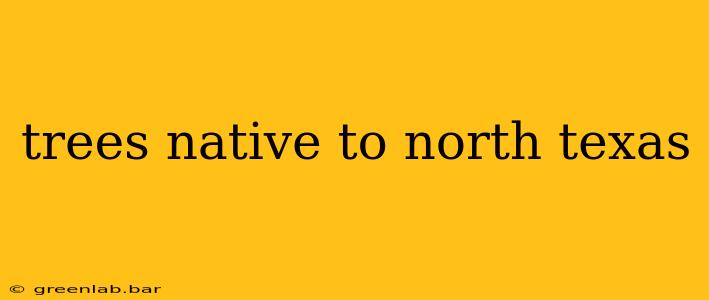North Texas boasts a diverse landscape, and its native trees play a vital role in maintaining the region's ecological balance and aesthetic appeal. Understanding the unique characteristics of these trees is crucial for both homeowners looking to landscape sustainably and environmentalists dedicated to preserving the region's natural beauty. This guide explores some of the most prominent trees native to North Texas, highlighting their features and benefits.
Common Native Trees of North Texas
North Texas' diverse climate supports a variety of tree species, each adapted to the specific conditions of the region. Here are some of the most commonly found native trees:
1. Texas Red Oak (Quercus buckleyi):
This majestic oak is a cornerstone of the North Texas landscape. Known for its striking reddish-brown fall foliage, the Texas Red Oak provides excellent shade and is relatively drought-tolerant once established. Its acorns are a crucial food source for wildlife.
- Key Features: Deep taproot, reddish-brown fall color, relatively fast growth rate.
- Ideal Conditions: Well-drained soil, full sun.
2. Bur Oak (Quercus macrocarpa):
The Bur Oak, recognizable by its massive, deeply lobed leaves and large acorns encased in fringed caps, is one of the most long-lived and resilient oak species in North Texas. It's incredibly adaptable and can thrive in a range of soil conditions.
- Key Features: Large size, long lifespan, drought-tolerant, massive acorns.
- Ideal Conditions: Tolerates various soil types, prefers full sun.
3. Live Oak (Quercus virginiana):
The iconic Live Oak, with its sprawling branches and evergreen foliage, is a symbol of the Texas landscape. It's a slow-growing tree, but its longevity and shade-providing capabilities make it a prized addition to any property.
- Key Features: Evergreen foliage, spreading canopy, long lifespan.
- Ideal Conditions: Well-drained soil, full sun to partial shade.
4. Lacebark Elm (Ulmus parvifolia):
This beautiful elm species is known for its exfoliating bark, which reveals a striking patchwork of colors. It is more resistant to Dutch Elm Disease than many other elm species, making it a popular choice for landscaping.
- Key Features: Exfoliating bark, attractive fall color, disease-resistant.
- Ideal Conditions: Well-drained soil, full sun to partial shade.
5. Eastern Redbud (Cercis canadensis):
Known for its vibrant pinkish-purple flowers that bloom in early spring, before the leaves emerge, the Eastern Redbud is a small to medium-sized tree that adds a splash of color to any landscape.
- Key Features: Early blooming flowers, heart-shaped leaves, relatively small size.
- Ideal Conditions: Well-drained soil, full sun to partial shade.
Benefits of Planting Native Trees in North Texas
Choosing native trees for your North Texas landscape offers numerous benefits:
- Environmental Conservation: Native trees support local ecosystems by providing habitat and food for native wildlife.
- Water Conservation: Once established, native trees are often more drought-tolerant than non-native species, reducing the need for supplemental watering.
- Reduced Maintenance: Native trees are better adapted to the local climate and soil conditions, requiring less maintenance than non-native species.
- Aesthetic Appeal: Native trees contribute to the unique beauty of the North Texas landscape.
Choosing the Right Native Tree for Your Landscape
Selecting the appropriate tree for your yard depends on several factors, including the available space, soil conditions, sunlight exposure, and your personal preferences. Consulting with a local arborist or native plant expert can help you make an informed decision. Remember to consider the mature size of the tree to ensure it will fit comfortably in your yard without interfering with power lines or buildings.
By understanding the diverse range of trees native to North Texas and the advantages of planting them, you can contribute to a healthier environment while enhancing the beauty and value of your property. Choosing native trees is a sustainable and environmentally responsible choice that benefits both you and the wider ecosystem.

